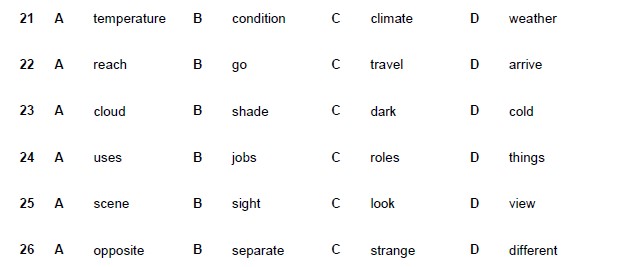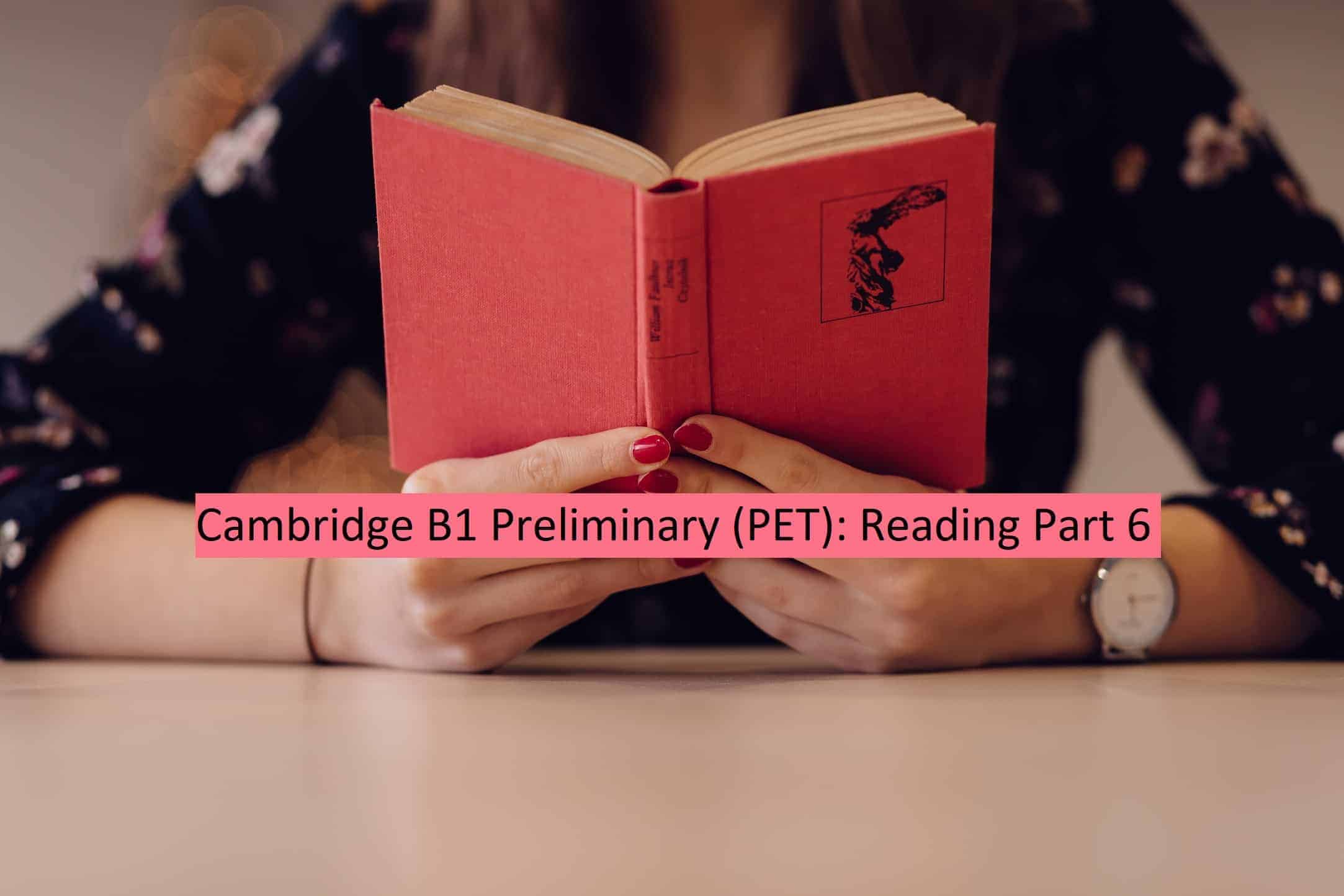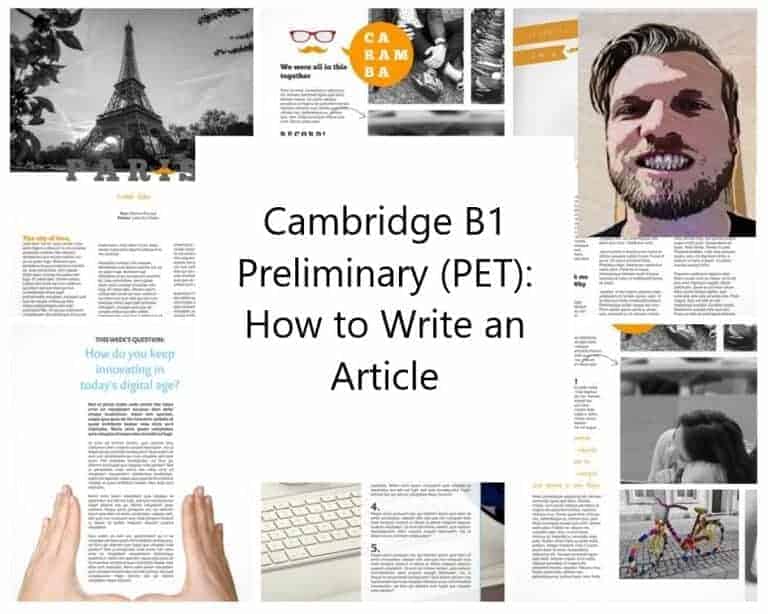Reading Part 5
In this article I’m going to give you detailed information about Reading Part 5 of the Cambridge English B1 Preliminary exam. You are going to learn what the task looks like, the biggest problems as well as tips and strategies to help you feel more confident and get high marks.
If you are interested in more general information, I recommend my article on everything you need to know about PET. There, you will find out more about the whole exam and it’s a good start if you are new to B1 Preliminary.
What do you have to do in Part 5?
4-option multiple choice cloze – In this part there is a shorter text with six gaps. For each gap you can choose from four options A-D.
Reading Part 5 mainly tests your vocabulary, but also some grammar.

Here you can see an example text. It is not very long with only around 150 words. There are also six numbered gaps. You have to put one word in each of those gaps. The possible answers look like the ones below:

There are always four options A-D for you to choose from.
You also need to remember that you have to transfer your answers onto a separate answer sheet. You get this sheet from the examiner at the beginning of the exam.
The Reading paper in the PET test has six parts in total. In every task you will find new problems as well as tips and tricks that are specific to each one. If you are interested in some more general information, you can read my article about B1 Preliminary Reading.
What is difficult about Part 5?
In Reading Part 5 there are some common problems that I have seen many times with my students. First, I’m going to show you what these problems are and after that we’re going to look at the best solutions.
Timing is important
When you take the B1 Preliminary test, you need to be aware of the strict time limit. In the Reading paper you only get 45 minutes to finish all six tasks. In some of the parts you have to read pretty long texts or you have to think about filling in gaps like in Part 5. Apart from that, you must also transfer your answers onto a separate answer sheet, which normally takes around five minutes. As a result, you only have 40 minutes to answer all the questions, or 6 1/2 minutes for each part.
Make sure that you always check your timing during the exam and don’t use too much time for one single task.
Don’t get confused by all the possible answers
Another very common problem is that many students get a little bit nervous because of the many different answer options. For each gap in Part 5 there are four possible answers and they are usually similar in meaning so it can become confusing very quickly.
It is important for you to understand exactly how the task works and what you can do in order to stay focused and relaxed.
Tips and strategies for Reading Part 5
In the previous part we looked at some common problems so now I’m going to show you the best way to do Reading Part 5. I hope that this information will be helpful for you when you take the exam.
Follow a step-by-step process
This tip is probably the most important one for every single part of the B1 Preliminary test. Always make sure that you know exactly what you have to do and create a plan that helps you when you get nervous or if you are running out of time. This way you can stay calm when everything becomes more stressful.
The step-by-step plan for Reading Part 5 might look like this:
- Read the text quickly
- Analyse the gaps
- Choose the correct answer
- Read the text again
Following a plan like the one above can give you extra confidence, but let’s have a look at it in more detail.
Read the text quickly
The first step is not a must, but I definitely recommend reading the text quickly to get a general understanding. Students often forget about the whole text and focus too much on individual gaps. Get a first idea and then move on to the meaty part of the task.
Analyse the gaps
Possibly the most important step of the whole process. After you have read the text quickly it is now time to look at the gaps. Remember that Part 5 mainly tests your vocabulary so you need to find out what possible expressions we can create with the words that are in front of and after the gaps.
Here is an example:

Choose the correct answer
So, before the gap the sentence mentions that coconut trees grow close to the ocean and that there is something hot and wet. There is a lot of ocean in the world so we are talking about something global and not just local.

Above are the possible answers. It is always a good idea to eliminate one or two options that just don’t work. For example, temperature is impossible because it can’t be wet. Weather is also not possible because we never say ‘a’ weather in English as weather is an uncountable noun.
That leaves us with condition or climate. The word we would use to describe the typical weather in an area is ‘climate’ so that is the correct answer.
Let’s do another example to make sure that everything is clear.


For question 22 we see that a verb is missing and the important thing here is that there is no preposition in the text. The only verb out of the four possible answers that we use without a preposition is reach. Go and travel need the preposition to (We can sometimes use go without a preposition, but only in very specific cases.) and arrive is used with at (He arrived at school five minutes late.) or in (It was raining when we arrived in France.).
You can see that you need to know these combinations of verbs and prepositions very well, but also other combinations of verbs and adjectives or nouns which are called collocations.
Read the text again
Once you finish with all the gaps, it is always a good idea to read the text one more time. We often focus too much on the details around each gap that we sometimes forget about the meaning of the whole text. Reading everything one last time can help you find mistakes that looked correct when you were concentrating on the gap, but in the full context of the topic you might realize that you need to choose a different option.
General tips
There are a few things you can do to generally get ready for the Reading paper of the B1 Preliminary exam.
First of all, try to read things in English as often as possible. Even if you only have five or ten minutes every day on the bus to or from work or school, use it practise some reading. Read whatever you want: the news, stories, articles or anything else you enjoy.
You will become a faster reader, which can save you time in the test, and you will see a lot of grammatical structures and new vocabulary that you might see again when you take the exam.
Secondly, think about taking English classes to prepare yourself specifically for the exam. It can be very helpful to have a teacher who can give you feedback on your typical mistakes and things you already do well so you know what you have to improve what you should focus on when getting ready for PET. To find a good school near you have a look at my article about everything you need to know about B1 Preliminary.
Last but not least. think about your time management and the order in which you want to go through the different tasks in the exam. If you want to know more, you can follow the link to my post about the Reading paper in the PET test.
Lots of love,
Teacher Phill 🙂












